On
8 Dec 1881 a huge lamp came down at the Ring Theatre in the Schottengasse,
Vienna. Soon the entire theatre was an inferno of fire and hundreds
of people lost their lives. Among them was Ladislaus Vetsera, whose
body disappeared into a mass grave at the Central Cemetery, Vienna.
Ladislaus was the oldest son of Albin, Baron Vetsera and his wife Helene
Baltizzi.
Albin Vetsera was a diplomat in foreign service at the Austrian court.
His family came from Pressburg (now Bratislava), in those days part
of Hungary. He was a rich man and with Helene Baltizzi he had four children.
A second sister to the aforementioned Ladislaus was born on 19 Mar 1871
and her name was Marie.
|
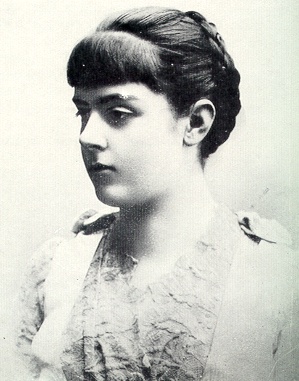 Mary
Vetsera (1871-1889)
Mary
Vetsera (1871-1889) |
When
Mary - as she preferred to call herself - was 17 years old she was
considered pretty by the standards of her time. She was small and
she had a slightly tinted skin. She had a sensuality about her that
attracted men and looked older than her age.
On 12 Apr 1888 Mary was at the horse races at the Freudenau in the
Prater and there her eyes met those of crown prince Rudolf. He smiled
to her and Mary started phantasizing immediately. Possibly Mary was
introduced to Rudolf by the British crown prince, but it seems that
Mary walked up to Rudolf herself and soon they started an affair.
Rudolf took her for walks at the Prater and gave her little gifts.
Countess Marie Larisch (1856-1940), the daughter of empress Elisabeth's
oldest brother Ludwig, helped her to gain access to his room.
|
By
Januari of 1889 they had become lovers and their affair was known by
lots of people including Emperor Francis Joseph himself. At the end
of January Rudolf had a serious argument with the emperor, possibly
about his liaison with the young baroness. On 29 Jan 1889 Rudolf and
Mary were together at the royal hunting lodge at Mayerling,
located 30 kilometers from Vienna. It's still unclear what happened,
but on the next morning both were found dead.
|
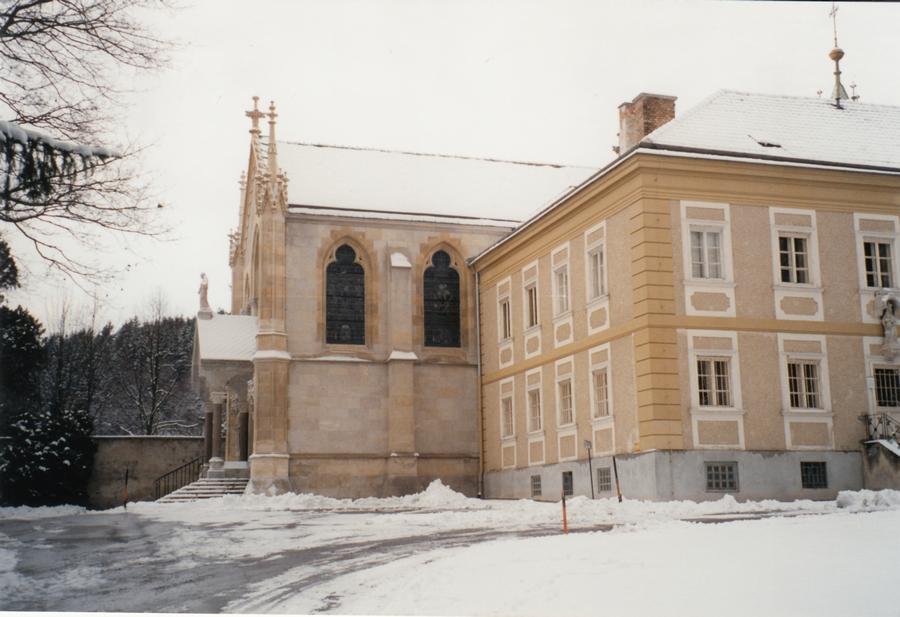 Mayerling
in 2001. The chapel on the left was built on
Mayerling
in 2001. The chapel on the left was built on
the place where Rudolf and Mary died.
|
|
When the news arrived at the Hofburg nobody had the courage to break
it to the emperor. The empress had just been told by Baron Nopcsa
that her son was dead when Francis Joseph headed for her appartments
to visit her after her Greek lesson. He was admitted to her room and
it is unknown what happened between them. Soon afterwards Elisabeth
called for Katharina Schratt to console her husband and sent for her
daughter Valerie. Valerie's first reaction was "Has he killed
himself?". But Elisabeth denied this vehemently. It seems that
she was told that Mary poisoned Rudolf and then herself. Only 24 hours
after the tragedy Francis Joseph learned to his astonishment that
Rudolf had shot himself. The official version was that the crown prince
had died from heart failure.
On examination of the bodies it soon became clear that Mary had died
several hours before Rudolf, indicating that he had killed her and
sat next to the body until he finally shot himself. One theory is
that Rudolf had suggested to commit suicide together and that she
- who was madly in love with him - was only too ready for the sacrifice.
Another suggests that Mary died of an abortion and that Rudolf was
so stricken with grief that he killed himself. Only one bullet was
found at the spot and eye witnesses that claimed she had a bullet
hole in her head may have made wrong observations in the confusion
of the moments they saw the body.
We may not know what happened that night and why, but it is certain
that Mary knew that she was going to die. She wrote letters to her
mother, her sister and her brother that were found a Mayerling. These
were brought to the emperor and later they were handed to Helena Vetsera's
brother in law Count Stockau under the strict condition that Helena
would only get one hour to read them. Mary wrote to her mother that
she would be happier in death than in life and that she wanted to
be buried beside Rudolf at the cemetery of Alland (one mile from the
monastery's cemetery at Heiligenkreuz).
There was the problem of Mary's body. The government had to get rid
of it quickly and secretly to hold on to the official version of Rudolf's
death. The "removal of the female body" was ordered. Dr.
Slatin (who was Secretary of the Court) was to go to Mayerling, together
with Rudolf's physician Dr. Auckenthaler. The police would take care
of the funeral arrangements. Because her death was understood to be
a suicide, some pressure wat put on the Abbott Grünbeck to allow
a Christian funeral. He gave this permission on the grounds that she
"had committed suicide because of a temporary loss of her senses"
(the same argument would be used to convince Pope Leo XIII in the
case of Rudolf). The Abbott also allowed the construction of a coffin
in the monastery's workshop. Grünbeck died in 1902 and his papers
were mysteriously destroyed.
Meanwhile, Mary's body had been placed in a storeroom until finally
her uncles Alexander Baltazzi and count Stockau were taken to it by
the police for identification. Late on Thursday night, nearly two
days after she had died, Mary's was put in a fur coat and a hat was
placed on her head to hide the wound (or at least to hide her face
from view). Her uncles lifted her body between them and walked with
it to the carriage that was waiting as if they were walking with a
living person. It's curious that such an act was put up for the few
meters from Mayerling to the carriage and even more strange that Mary's
uncles didn't refuse to participate in it.
Mary sat between her uncles during this sinister ride and her body
fell forward all the time as the carriage drove to the monastery of
Heiligenkreuz. They had to attach a broomstick to it to keep her upright.
The carriage reached Heiligenkreuz Monastery at 10 pm.
|
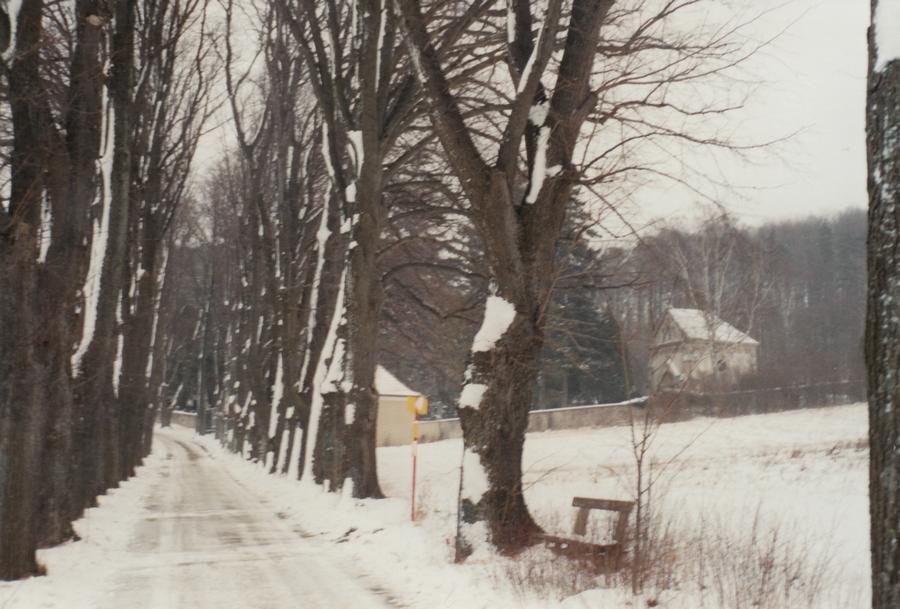
The road to the cemetery of the monastery of
Heiligenkreuz in the year 2001.
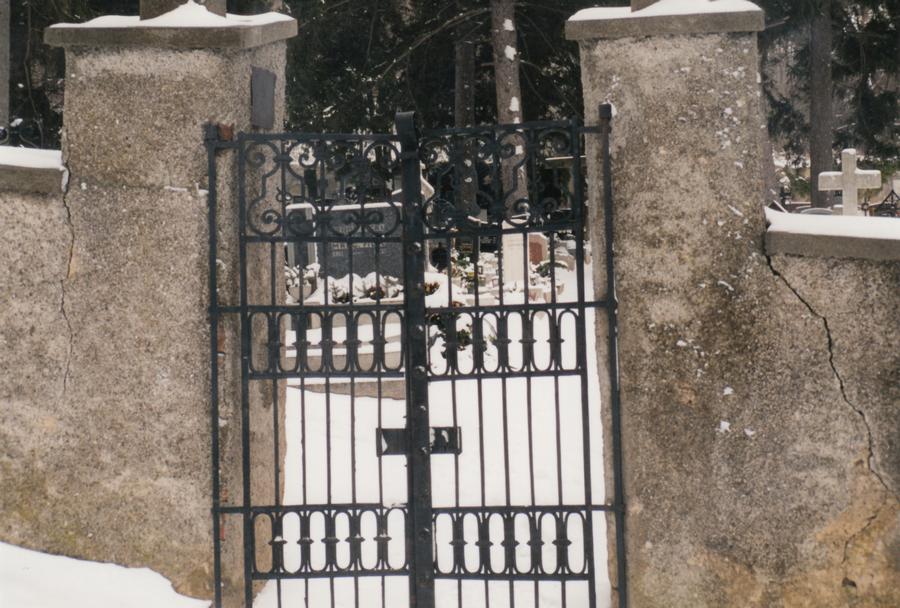
The gates of the cemetery.

The snowy cemetery (Mary's grave is in the middle near the wall). |
|
The weather was bad and it was close to midnight when they were at
the gates of the cemetery, that was guarded by 30 police officers.
The body was taken to the mortuary and put into the wooden coffin.
The hat she was wearing was now put under her head. But because of
the wind and the cold the grave wasn't ready yet. Mary wasn't buried
before nine o'clock the following morning. Her grave was 20 meters
from the mortuary and all that were present helped to let the coffin
down in the grave.
Hanna
Vetsera wasn't able to attend the funeral. In a desparate attempt
to find her missing daughter she had spoken to the empress who had
told her Mary was dead. After she had left Elisabeth, Helena was told
that it was in her best interests to leave Vienna for the time being,
since she might be in danger from the moment it became known to the
public that her daughter had murdered Rudolf (which Mary hadn't).
So Hanna Vetsera left Vienna for the time being and wasn't there when
here daughter was buried.
It's not clear who coordinated this inhuman sequence of events. Probably
it was prime minister Taaffe. It's certain, however, that emperor
Francis Joseph knew about it and didn't stop it. For this was exactly
what they wanted: Mary Vetsera had simply disappeared from the earth.
Aftermath
On 16 May 1889 Mary's temporary grave was opened and she was moved
to a permanent grave a few yards away that was commisioned by her
mother. The wooden coffin was replaced by a copper one and a simple
monument was erected, carrying the following inscription:
MARY
FREIIN v. VETSERA
Geb. 19 März 1871
Gest. 30 Jänner 1889
Wie eine Blume
sproszt der
Mensch auf und wird gebrochen
Hiob. 14,2
(like a flower a human being sprouts and is broken)
|
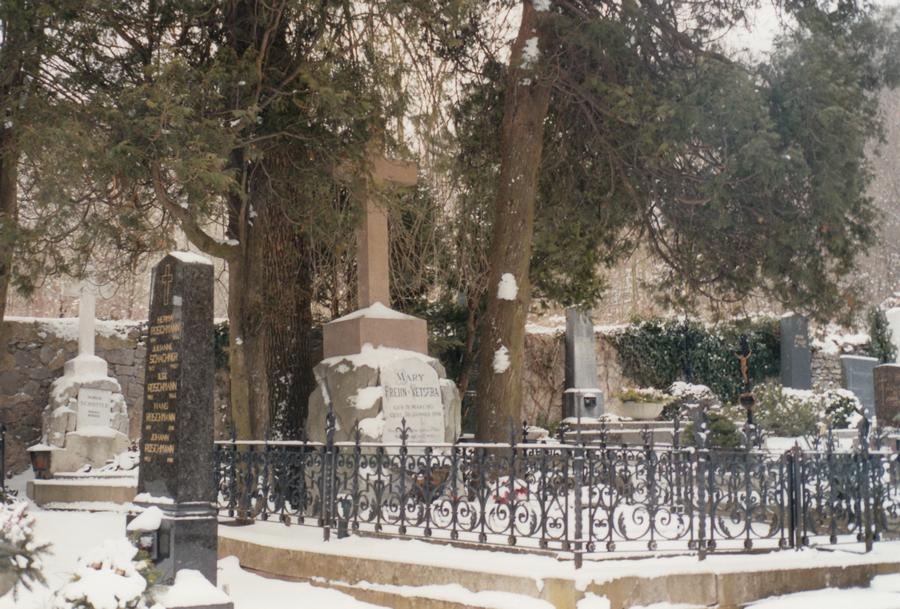 Mary's
grave on 1 Feb 2001.
Mary's
grave on 1 Feb 2001.
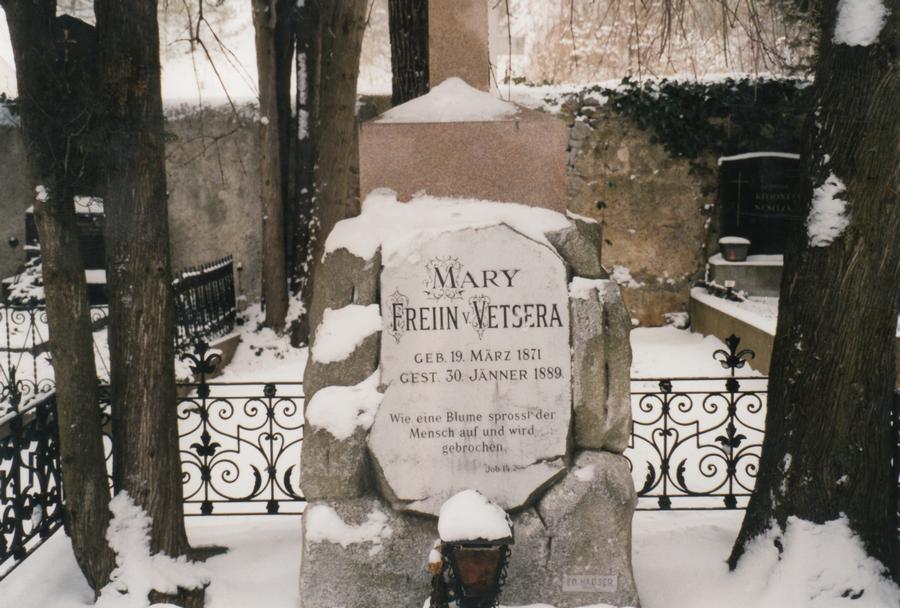 Mary's
grave
Mary's
grave.
|
|
Hanna Vetsera had a chapel erected opposite of the entrance of the
cemetery. It has a window that shows the Holy Mary and two angels
with the faces of Mary (Vetsera) and her brother Ladislaus. Hanna
wanted the Holy Mary to have the face of her Mary, but this was forbidden
by the monastery. The chapel has a plague with an inscription in Latin,
but the name of Vetsera was not allowed to appear there by order of
the court. The one consoling point is that Abbott Grünbeck promised
the grieving mother that the grave would never have another destination
and that the chapel would be preserved by the monastery.
What happened to the other Vetsera's?
Baron Vetsera had died before Mary of a lung disease in 1887.
Mary's sister Hanna married the Dutch count Hendrik van Byland in
1897 and lived in Zoeterwoude (near Leiden) in Holland. But when they
were in Rome for the winter she miscarried and had hardly healed before
she died from typhoid fever in 1902, only 32 years old. She was in
the posession of a rare copy of the protest that her mother issued
against the way the Austrians had treated the affair. Most other copies
of this "Denkschrift Über Die Katastrophe Von Mayerling"
were located and destroyed by the secret police.
Feri, the second son of the Vetsera's, married Magrit, countess of
Bissingen. They had three children. During the First World War he
died in Poland on October 22, 1915.
Baroness Hanna Vetsera had lost her last child and she also lost her
wealth during the inflation of the twenties. She had to sell her house
and lived in modest circumstances at the Prinz Eugenstrasse. There
she died impoverished on 1 Feb 1925.
In later years the mystery of Mayerling was never fully solved. In
1945 Mary's tomb was opened by plundering Russians who had fought
in the neighbourhood. The copper coffin was broken and when the fathers
of the monastery repaired the grave they saw a small skeleton in the
damaged coffin. The skull was there and seemd to be undamaged.
In 1959 the act of the Russians was considered once more and it was
suspected that the skull was somewhere outside the coffin. The grave
was opened to perform a reburial. Now the bones were all over the
coffin. Mary's small shoes were still there and a lot of long black
hair was collected. Once more witnesses declared that the skull had
not been hit by a bullet. It was slightly damaged, but that was probably
done by the Russians in 1945. When further research was requested
in 1979, a new exhumation of the body was refused by Abbott Franz
Gaumannmüller on human grounds.
But the story still doesn't end there. On 8 Jul 1991 the coffin was
stolen from the grave by Helmut Flatzelsteiner (a furniture merchant)
and two accomplices. Flatzelsteiner had lost his wife and it seems
he had become obsessed by solving the Mayerling mystery. He took the
coffin home to Linz and examined its contents. Then he even took
the remains to a medical specialist without disclosing Mary's identity.
The Neue Kronen Zeitung newspaper in Vienna was anonymously informed
that Mary's grave was empty and to the surprise of the police this
turned out to be true when on 22 Dec 1992 it was opened in the presence
of the press. It seems that the correspondent was Flatzelsteiner himself,
who confessed to his deeds. Mary's remains were taken to the Legal
Medical Institute in Vienna for further examination. The bones in
question were indeed a hundred years old and those of a woman around
twenty, but part of the skull was missing. At this time the (and after
a lot of legal confusion) the examination was stopped because the
body was released for reburial and handed over to the abbott of Heiligenkreuz,
Gerhard Hradil. A reburial was also the wish of Hermann Swistun,
who had been appointed trustee of Mary's estate by Nancy (d.1990)
and Nora (d.1991), the daughters of Mary's brother Franz Albin (d.1915).
However,
according to Hermann Swistun, careful examination of the photographs
showed evidence of a bullet entrance hole and another hole where the
bullet might have left the skull.
Mary's
remains were put to rest once more on the early morning of 28 Oct
1993, under the guiding eyes of Gerhard Hradil and Hermann Swistun
(Swistun had been handed over most of the Vetsera archive in the
1960s and died in 1999; after his death the archives had disappeared;
it seems that several items were sold or destroyed and the archive
is lost forever). There are probably no more answers to be found in
Mary's tomb, but the mystery lingers on!
|
Sources:
- Conte Corti, Elisabeth, Die Seltsame Frau, Anton Pustet,
Salzburg, 1936.
- Brigitte Hamann, Rudolf, Kronprinz und Rebell, Amalthea,
Wien, 1978
- Joan Haslip, The Lonely Empress, A biography of Elisabeth
of Austria, Weidenfeld and Nicholson, London, 1965
- Jean-Marc Nothias, Le Profanateur arrêté, Point
de Vue M2393, Cavenne Éditeurs, 1992.
- Hermann Swistun, Mary Vetsera, Gefährtin für den
Tod, Ueberreuter, Wien, 1999.
- S. van der Werff, Het drama van Mayerling, De Bataafsche
Leeuw, Amsterdam, 1991
|






